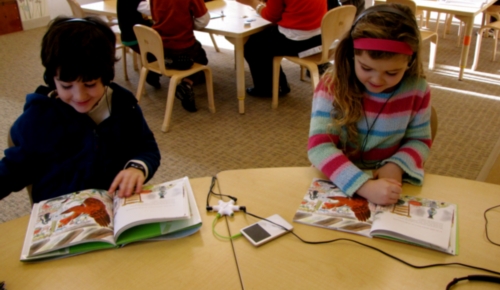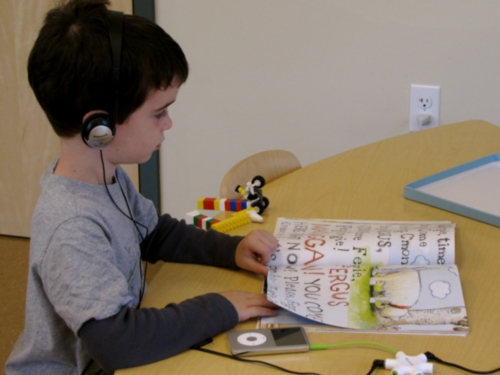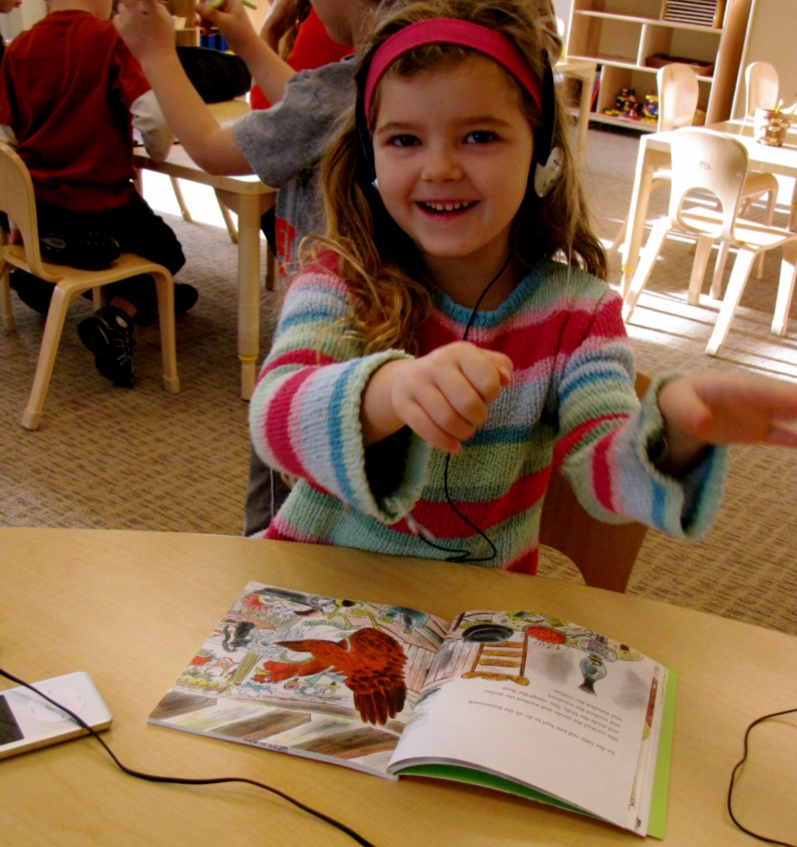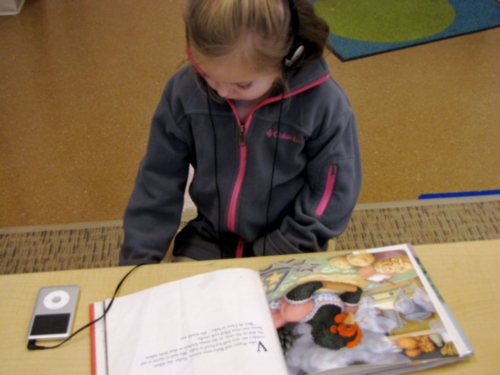Description
iPods are small portable devices designed to store and play digital music or the spoken word. In the case of the iPod Touch which is a mini handheld computer, there is also the built-in capacity to access the Web, play interactive games, and utilize a variety of specifically programmed software similar to that found on the iPad.
We know that one of the most important literacy experiences that children can have is being read to. While teachers would like to be available to read to every child on demand, that is not always possible. The iPod became the newest tool for allowing children to hear stories being read. From records to tapes and now to digital formats, recorded books are an extremely popular way to enjoy stories. iPods have the  advantage of allowing large numbers of books to be stored in a small space. Downloaded from iTunes, or recorded yourself, these recordings of books are perfect for those moments when a teacher, parent or other more competent reader is not available to read in person. Because of the size of the device, is easy for a child to take it just about anywhere in a classroom and with a pair of headphones, listen to a story. There are many available adapters that will allow multiple people to hear the story simultaneously, each through their own pair of headphones. The use of iPods in the classroom has been dwindling as of late because this technology is subsumed in the more powerful iPod Touch, and iPad, both of which contain the iPod application as part of its standard set of tools. This means that you might be able to ask parents at your school to donate their old iPods for the reading center of your program. advantage of allowing large numbers of books to be stored in a small space. Downloaded from iTunes, or recorded yourself, these recordings of books are perfect for those moments when a teacher, parent or other more competent reader is not available to read in person. Because of the size of the device, is easy for a child to take it just about anywhere in a classroom and with a pair of headphones, listen to a story. There are many available adapters that will allow multiple people to hear the story simultaneously, each through their own pair of headphones. The use of iPods in the classroom has been dwindling as of late because this technology is subsumed in the more powerful iPod Touch, and iPad, both of which contain the iPod application as part of its standard set of tools. This means that you might be able to ask parents at your school to donate their old iPods for the reading center of your program.
Suggestions for use
will need to be charged occasionally so storing them in a place where they can be accessed by students and yet easily charged is an important forethought. Each listener will need a pair of headphones so these will need to either be stored nearby, or left plugged into the pod. There are many excellent uses for this tool so let's start with the obvious. Prerecorded books can be purchased on iTunes or purchased on CDs and transferred to the pod. Then it is a matter of initially teaching the students how to access the library of books, and how to control the volume control on the device.
 Read along Read along
Many of the available digital books are designed to be read with the books and contain a sound indicating when to turn the page. This can be a particularly empowering and gratifying way to enjoy a book, because children can start by enjoying the story and the images and as they develop more competence as a reader they can follow along word-by-word. If teachers are quite intentional about which books are available, providing those books that contain a limited number of words helps to provide the students with the word/sound/image connections. Children right on the cusp of constructing this relationship can find these books extremely compelling and will want to visit and revisit the same books that are within this zone of proximal development.
Record your Own
With a relatively inexpensive microphone, or by using a computer and the Apple program garageband, it is possible for teachers to easily record their own classroom books or stepped readers. With a directive to "please turn the page at this sound", students could then follow along on the correct page. There is something comforting for children hearing their own teacher read a book. Teachers could also use iPods for class podcasts either created by or for the students. With parents subscribed to the RSS feed, they can follow along as new content is added.
|
|
Assessment
iPods are a very easy and unobtrusive tool to use for purposes of formative and summative authentic assessments. Recording each child reading at the beginning of the year, and then prior to a conference, allows parents to hear their child's progress in your class. This can also be gratifying for a child to hear how much they have progressed with their reading skills. |
Music Appreciation
 Using an iPod to play music for children to enjoy can be another important application that is frequently overlooked. Recording some of the class' favorite songs, or some other appropriate music can serve as a differentiation or extension for materials students are exploring. Recognizing that there are multiple ways that individuals manifest intelligence, and acknowledging the importance of empowering a range of learners and styles, allowing a musical outlet in the classroom is an element of a universal design for supporting all learners. From Sammy, to the Wheels on the Bus, to Fifty Nifty United States, music can teach and inspire. It can also serve as the perfect tool to help children who benefit from a removing themselves acoustically from the classroom for a rest, or because they want to relax. Using an iPod to play music for children to enjoy can be another important application that is frequently overlooked. Recording some of the class' favorite songs, or some other appropriate music can serve as a differentiation or extension for materials students are exploring. Recognizing that there are multiple ways that individuals manifest intelligence, and acknowledging the importance of empowering a range of learners and styles, allowing a musical outlet in the classroom is an element of a universal design for supporting all learners. From Sammy, to the Wheels on the Bus, to Fifty Nifty United States, music can teach and inspire. It can also serve as the perfect tool to help children who benefit from a removing themselves acoustically from the classroom for a rest, or because they want to relax.
|
|




 advantage of allowing large numbers of books to be stored in a small space. Downloaded from iTunes, or recorded yourself, these recordings of books are perfect for those moments when a teacher, parent or other more competent reader is not available to read in person. Because of the size of the device, is easy for a child to take it just about anywhere in a classroom and with a pair of headphones, listen to a story. There are many available adapters that will allow multiple people to hear the story simultaneously, each through their own pair of headphones. The use of iPods in the classroom has been dwindling as of late because this technology is subsumed in the more powerful iPod Touch, and iPad, both of which contain the iPod application as part of its standard set of tools. This means that you might be able to ask parents at your school to donate their old iPods for the reading center of your program.
advantage of allowing large numbers of books to be stored in a small space. Downloaded from iTunes, or recorded yourself, these recordings of books are perfect for those moments when a teacher, parent or other more competent reader is not available to read in person. Because of the size of the device, is easy for a child to take it just about anywhere in a classroom and with a pair of headphones, listen to a story. There are many available adapters that will allow multiple people to hear the story simultaneously, each through their own pair of headphones. The use of iPods in the classroom has been dwindling as of late because this technology is subsumed in the more powerful iPod Touch, and iPad, both of which contain the iPod application as part of its standard set of tools. This means that you might be able to ask parents at your school to donate their old iPods for the reading center of your program.
 Read along
Read along
 Using an iPod to play music for children to enjoy can be another important application that is frequently overlooked. Recording some of the class' favorite songs, or some other appropriate music can serve as a differentiation or extension for materials students are exploring. Recognizing that there are multiple ways that individuals manifest intelligence, and acknowledging the importance of empowering a range of learners and styles, allowing a musical outlet in the classroom is an element of a universal design for supporting all learners. From Sammy, to the Wheels on the Bus, to Fifty Nifty United States, music can teach and inspire. It can also serve as the perfect tool to help children who benefit from a removing themselves acoustically from the classroom for a rest, or because they want to relax.
Using an iPod to play music for children to enjoy can be another important application that is frequently overlooked. Recording some of the class' favorite songs, or some other appropriate music can serve as a differentiation or extension for materials students are exploring. Recognizing that there are multiple ways that individuals manifest intelligence, and acknowledging the importance of empowering a range of learners and styles, allowing a musical outlet in the classroom is an element of a universal design for supporting all learners. From Sammy, to the Wheels on the Bus, to Fifty Nifty United States, music can teach and inspire. It can also serve as the perfect tool to help children who benefit from a removing themselves acoustically from the classroom for a rest, or because they want to relax.